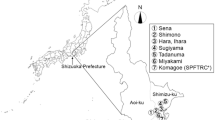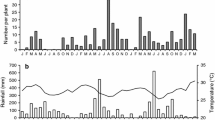Abstract
Aleurothrixus floccosus (Homoptera: Aleyrodidae) first invaded eastern urban areas of Athens, Greece, in May 1991. At Zographou, Athens, in 1992–1994, most overwinteringA. floccosus nymphs were of the 3rd and 4th instars, and pupae; during other periods of the year, all developmental instars were found, at fluctuating rates. In 1993, peaks in the numbers of eggs laid coinciding with sharp increases in percentage of 1st instar nymphs found permitted the distinction of 6 overlap** generations.
High densities ofA. floccosus infesting citrus in autumn 1992, in the range of 9.1–10.9 nymphs/cm2 leaf surface, were brought under control by autumn 1993, with maximum densities of 1.1–1.7 nymphs/cm2. This reduction is attributed mostly to the action of the introduced parasitoidCales noacki (Hymenoptera: Aphelinidae), released 3 km from Zographou in 1992 and at Zographou itself in 1993. No indigenous parasitoid was ever found parasitizingA. floccosus.
The first record ofClitostethus arcuatus (Coleoptera: Coccinellidae) in Greece is reported. In summer 1992, eggs larvae and adults ofC. arcuatus were noticed on citrus leaves infested withA. floccosus at Zographou. From 1992 to 1994, the adults were often detected in field samplings and on yellow sticky traps.
C. arcuatus adults and larvae were successfully reared, under optimal laboratory conditions, on eggs and early-instar nymphs ofA. floccosus and on eggs ofAnagasta kuehniella (Lepidoptera: Pyralidae), but the adults did not reproduce.
Résumé
Aleurothrixus floccosus, a envahi pour la première fois les régions urbaines de l’est d’Athènes, Grèce, en mai 1991. Dans la région de Zographou à Athènes, en 1992–1994, la plupart desA. floccosus en hivernation, étaient des 33 et 4e stades larvaires et des nymphes. Pendant les autres périodes de l’année, tous les stades de développement ont été trouvés en pourcentages variables. Au cours de 1993, les pics du nombre d’ œufs pondus, notés presque en même temps que les pics de larves du 1er stade, ont permis de distinguer 6 générations chevauchantes.
Des densités élevées d’A. floccosus observées sur les agrumes à l’automne 1992, avec 9.1–10.9 larves/cm2 de surface foliaire, ont été limitées à l’automne 1993 à des densités maximum de 1.1–1.7 larves/cm2. Cette limitation est essentiellement due à l’action du parasitoïde introduitCales noacki (Hymenoptera : Aphelinidae), lâché à une distance de 3 km de Zographou en 1992 et dans la region de Zographou elle même en 1993. Aucun parasitoïde indigène n’a été observé surA. floccosus.
La découverte deClitostethus arcuatus (Coleoptera : Coccinellidae) est rapportée pour la première fois en Grèce. Des œufs, des larves et des adultes deC. arcuatus ont été trouvés sur feuilles d’agrumes infestées parA. floccosus, dans la region de Zographou, en été 1992. De 1992 à 1994, les adultes ont été souvent trouvés lors des échantillonnages sur le terrain et sur les pièges jaunes englués.
Des larves et des adultes deC. arcuatus ont été élevés avec succès, dans des conditions de laboratoire favorables, sur les œufs et les jeunes larves d’A. floccosus, ainsi que, sur les œufs d’Anagasta kuehniella (Lepidoptera : Pyralidae); néanmoins les adultes ne se sont pas reproduits.
Similar content being viewed by others
References
Abbassi, M. &Onillon, J. C. — 1973. La mouche blanche floconneuse,Aleurothrixus floccosus Mask. ravageur dangereux pour l’agrumiculture marocaine. —Maroc Fruits, 441, 1–3.
Carrero, J. M. — 1979. Contribution al estudio de la biologia de la “mosca blanca” de los agriosAleurothrixus floccosus Mask. en la region Valenciana. IV Parasitismo perCales noacki How. —Anales del Instituto Nacional de Investigaciones Agrarias, Serie: Proteccion Vegetal, 9, 152–176.
De Bach, P. &Rose, M. — 1976. Biological control of Wooly Whitefly. —California Agriculture, 30, 4–7.
Ekbom, B. S. &Rumei, X. — 1990. Sampling and spatial patterns of whiteflies. In: Whiteflies: their Bionomics, Pest Status and Management. (D. Gerling, ed.). —Intercept Ltd, Andover, Hants(U.), 107–121.
Katsoyannos, P. — 1984. The establishment ofRhyzobius forestieri (Col.: Coccinellidae) in Greece and its efficiency as an auxiliary control agent against a heavy infestation ofSaissetia oleae (Hom.: Coccidae). —BioControl, 29, 387–397.
Katsoyannos, P. — 1991. First record ofAleurothrixus floccosus (Mask.) (Homoptera: Aleyrodidae) in Greece and some observations on its phenology. —Entomologia Hellenica, 9, 69–72.
Katsoyannos, P. — 1994. Rearing method ofCales noacki, natural enemy of the wooly whitefly. —Agriculture Crop and Animal Husbandry, 4, 32–34 (in Greek).
Liotta, G. — 1982. La mosca bianca floccosa degli agrumi. —Informatore Fitopatologico, 32, 11–16.
Liotta, G. &Maniglia, G. — 1983. Introduzione, allevamento e diffusione di nemici naturali indigeni ed esotici diAleurothrixus floccosus (Mask.) (Hom., Aleyrodidae). II Ruolo diCales noacki How. (Hym., Aphelinidae) nel controllo diAleurothrixus floccosus (Mask.) in Sicilia. —Phytophaga, 1, 133–142.
Moreno Vasquez, R. — 1973. Ciclo evolutivo deAleurothrixus howardi Quaint. en Malaga (Espana). 10 Congresso Mundial de Citricultura. Murcia-Valencia (Espana), 1, 417–425.
Mound, L. A. &Halsey, S. H. — 1978. Whitefly of the World. A Systematic Catalogue of the Aleyrodidae (Homoptera) with Host Plant and Natural Enemy Data. —J. Wiley and Sons, Chichester, U.K., 340 pp.
Onillon, J. C. — 1969. A propos de la présence en France d’une nouvelle espèce d’Aleurode nuisible aux citrusAleurothrixus floccosus Mask. (Homopt., Aleurodidae). —C.R. Acad. Agr. France, 55, 937–941.
Onillon, J. C. — 1973. Contribution à l’étude de la dynamique des populations d’Homoptères inféodés aux Agrumes. V.2. Possibilités de régulation des populations d’A. floccosus Mask. (Homopt., Aleurodidae) sur agrumes parCales noacki How.(Hymenopt., Aphelinidae). —OEPP/EPPO Bulletin, 3, 17–26.
Ortu, S. — 1983. Una nuova introduzione in Sardegna:Aleurothrixus floccosus (Mask.) nocivo agli agrumi. In: Proceedings E. C. Experts’ Meeting (R. Cavalloro & R. Prota, eds.). October 1982, Siniscola Muravera, Italy, 27–28.
Silva Magalhaes, G. — 1979. Note on the introduction ofAleurothrixus floccosus (Mask.) (Homoptera, Aleurodidae) in south Portugal and its control byCales noacki How. (Hymenoptera, Aphelinidae). In: IOBC/WPRS Proceedings Intern. Symposium of IOBC/WPRS on Integrated Control in Agriculture and Forestry, October 1979, Wien, 572–573.
Vulic, M. &Beltran, J.L. — 1977. Die weisse fliegeAleurothrixus floccosus, ein gefähricher Schadling der Citruskulturen. —Z. Pflanzenkzo Pflanzerschutz, 84, 202–214.
Author information
Authors and Affiliations
Rights and permissions
About this article
Cite this article
Katsoyannos, P., Ifantis, K. & Kontodimas, D.C. Phenology, population trend and natural enemies ofAleurothrixus floccosus (Hom.: Aleyrodidae) at a newly invaded area in Athens, Greece. BioControl 42, 619–628 (1997). https://doi.org/10.1007/BF02769820
Received:
Accepted:
Published:
Issue Date:
DOI: https://doi.org/10.1007/BF02769820




